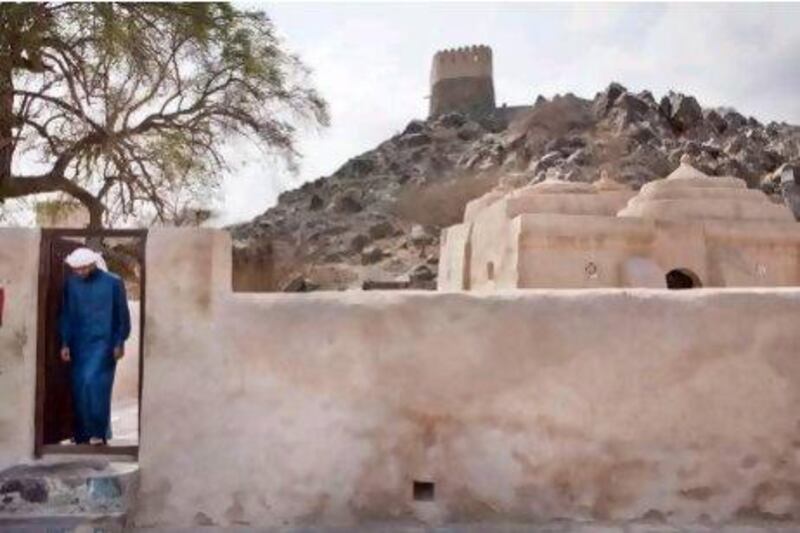DUBAI // He may not know it, but Ourangzaib Alamgir is part of a way of life that once defined the essence of Dubai.
The Pakistani, 32, owns a small company that helps traders to load their goods on to traditional dhows along the banks of the Dubai Creek.
Once full, the vessels leave the creek and cross the Arabian Gulf and Arabian Sea, with Iran and Somalia their most frequent destinations.
Most of the manual workers servicing the industry are foreigners, but the culture of sea-faring and trading across borders is at the very heart of Dubai's heritage.
The emirate now hopes for global recognition of the creek's cultural significance, with authorities saying yesterday they want to have it listed as a World Heritage site.
If Dubai Municipality is successful, the creek will join Al Ain on the prestigious list that includes Egypt's pyramids and India's Taj Mahal.
The UN Educational, Scientific and Cultural Organisation (Unesco) includes sites on the list if they meet certain criteria.
They must represent a masterpiece of human creative genius and be directly associated with historical events or living traditions, ideas or beliefs, among other standards.
Rashad Bukhash, the head of the architectural heritage department at Dubai Municipality, believes the creek, also known as Khor Dubai, fully deserves this status.
"This is where Dubai started from," Mr Bukhash says, explaining records show a vibrant culture of sea-faring and trading that is more than 150 years old.
The area, which has already been included on the Unesco World Heritage tentative list, comprises the mouth of the creek and the first 4.5 kilometres.
It includes the quay and piers of the harbour along the banks of the creek, where the dhows moor. It also includes the areas of Bastakiya and Shindagah, with their well-preserved traditional buildings.
The Faheidi Fort and souqs, including the Bur Dubai souq, are also in the proposed area.
"Tourists always come to Dubai to see the modern attractions. They are not thinking of the creek," says Dr Eman Assi, cultural heritage expert at Dubai Municipality.
"It used to be the heart of Dubai, from there the whole city developed. It is a very authentic experience in Dubai, which is still existing."
Regardless of the time of year, the creek is generally bustling with activity. Commercial dhows, dinner cruises, abras and water taxis ply the busy water route between the trading centres of Bur Dubai and the commercial centre of Deira every day.
It will take about two years before officials know whether Dubai Creek has made it to the final World Heritage list. The first draft of an application, explaining its cultural and heritage value and the measures to preserve it, should be submitted to Unesco this September.
The final draft is expected for submission in December. Then a team of international experts will visit to independently evaluate the creek's potential.
The experts may raise some points and discussions with Dubai Municipality that could take up to 18 months.
The final discussion of the nomination file and a decision are expected in June 2014.
Al Ain was included in June last year for locations including Jebel Hafeet, Hili, Bida bint Saud, its six oases and the man-made water system of falaj.
There are five other UAE sites on this year's tentative World Heritage list. They include the island of Umm Al Nar in Abu Dhabi, where there are about 50 tombs dating from between 2,500 and 2,000BC.
The island's residents from those times smelted copper and traded with Mesopotamia and the Indus Valley.
Sharjah is represented by Sir Bu Nair Island, home to rare marine life including turtles, and by the emirate's central region, where there are five archaeological sites of various ages.
Among them is Al Buhais Mountain, which contains many tombs from the fifth millennium BC.
Also on the list is Al Bidya Mosque in Fujairah, the UAE's oldest place of worship. A site in Umm Al Quwain, the Ed-Dur temple, offers a glimpse into life before the arrival of Islam.
Back along the banks of the Dubai Creek yesterday, Mr Alamgir was not aware of the Unesco bid. On his mind was a more practical matter.
Political disagreement between the US and Iran has greatly decreased trade with the UAE's neighbour.
This means fewer traders need the services of his loading company. From a monthly average of Dh1,000 or Dh2,000, his income has dropped to as little as Dh500, Mr Alamgir says.
When asked about the future, he gives a response that is often heard in the region.
"Inshallah," he says, his gaze looking up. "God bless. We wait for God bless."
* With additional reporting by Rym Ghazal






